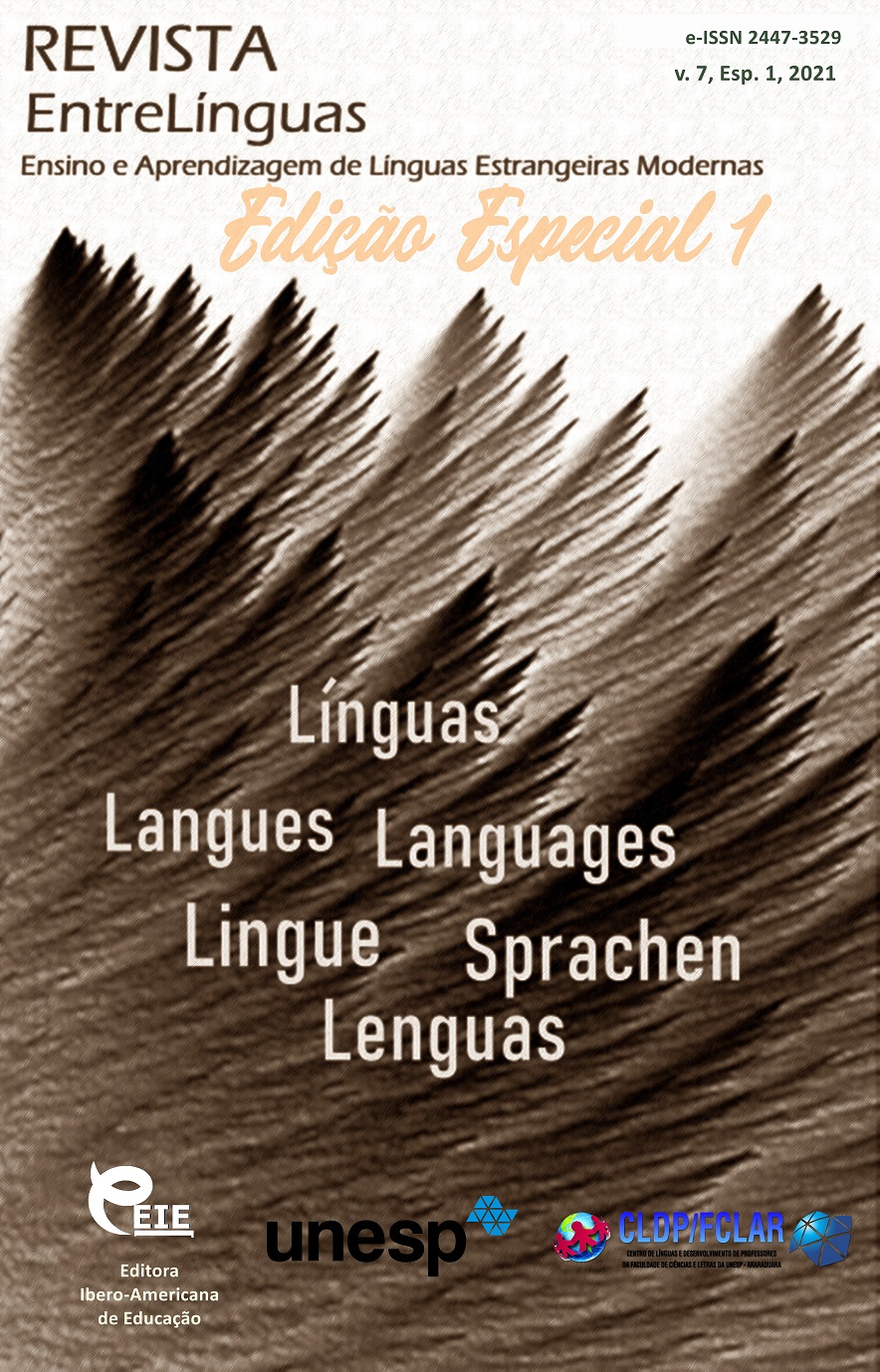Verbo como meios de representação de optatividade em línguas diferentemente estruturadas
DOI:
https://doi.org/10.29051/el.v7iEsp1.14891Palavras-chave:
Optatividade, Humor desejável, Tradução literária, Semântica, Tártaro, InglêsResumo
O artigo tem como objetivo analisar a especificidade dos meios lexicais e gramaticais que expressam a semântica da optatividade em tártaro e inglês. O exame do assunto em questão com base em trechos literaturários é explicado por um uso difundido de verbos optativos na ficção, uma vez que são direcionados à esfera exclusivamente inerente ao mundo interior de uma pessoa. A fase final do estudo aborda a concretização social e pragmática das peculiaridades linguísticas do vocabulário verbal que expressa o modo optativo em línguas de estrutura diferentes – o tártaro e o inglês. A atualidade do estudo é fundamentada pelo fato de que a categoria do modo optativo verbal na linguística do mundo moderno não é tema de um estudo especial no momento. A cobertura insuficiente da categoria linguística de optatividade inicia principalmente no interesse considerável em seu estudo comparativo de contraste, que é permitir determinar os limites de formas gramaticais e unidades lexicais que expressam a semântica de desejo e identificando suas características semânticas. A complexidade do estudo é causada pelo ponto em que o artigo trata de uma tradução não mediada de belles-lettres do inglês para o tártaro sendo línguas de estrutura diferente e geneticamente não relacionadas, o que também atesta a atualidade do estudo.
Downloads
Referências
ALTABAEVA, E.V. Optive sentences in modern Russian: a textbook. Michurinsk, 2003. 164 p.
GABDRAKHMANOVA, F. H.; NURMUKHAMETOVA, R. S.; SATTAROVA, M. R. Peculiarities of transmission of American culture in Russian translated texts. Modern Journal of Language Teaching Methods, n. esp., p. 32-36, 2016.
GABDRAKHMANOVA, F. H.; ZAMALETDINOVA, G. F.; ZAMALETDINOV, R. R.; SATTAROVA, M. R. The national-cultural values of the Tatars in paremies with lexemas “oy / yort” (house)''. Revista Turismo Estudos & Práticas (RTEP), v. 8, n. 1, p. 1-7, 2019.
GABDULLAZIYANOVA, G. I.; NURMUKHAMETOVA, R. S.; BOLGAROVA, R. M. Etymological Dictionary of the Tatar Language as the Source of Turkic Language Vocabulary Comparative Study. Modern journal of language teaching methods, v. 8, n. 11, p. 346-351, 2018.
KOBRIN, N. A. English grammar: morphology. St. Petersburg: Soyuz Publishing House; Lenizdat, 2000. 496 p.
KOMISSAROV, V. N. Modern translation: a training manual. Moscow: ETS., 2002. 424 p.
SIBGAEVA, F. R.; SALAKHOVA, R. R.; MUKHAMEDOVA, S. Representation of person emotional state in the Tatar Language picture of the world. AD ALTA: Journal of interdisciplinary Researc, v.7, p. 260-262, 2017.
SUNGATOVA, G. F. Desirable mood in the Turkic literary monuments of the XIV century. Scientific notes of Kazan University. Series Humanities, n. 8, p. 128-134, 2008.
TATAR grammar. Tatar book. 3 volumes. Kazan: Publishing House, 1993. T. II, 397 p.
TWAIN, M. The adventures of Tom Sawyer: the adventures of huckleberry finn: a novels. Moscow: Foreign lang. publ. house, 1956. 575 p.
YERBULATOVA, I. K.; GILAZETDINOVA, G. K. H.; BOZBAYEVA, A. G. Peculiarities of translation of kazakh realities with a cultural historical component of meaning. International Journal of Higher Education, v. 8, p. 51-54. 2019.
YUISUFUVA, Z. et al. Paroemiological units of the tatar language with culture-specific. Modern Journal of Language Teaching Methods, n. esp., p. 161-165, 2016.
ТWAIN, М. Tom Sojer magaralary: roman. Kazan: Megarif. 2003. 271 p.
Downloads
Publicado
Como Citar
Edição
Seção
Licença

Este trabalho está licenciado sob uma licença Creative Commons Attribution-NonCommercial-ShareAlike 4.0 International License.
Os manuscritos aceitos e publicados são de propriedade da Revista EntreLínguas. Os artigos publicados e as referências citadas na Revista EntreLínguas são de inteira responsabilidade de seus autores.
Transferência de direitos autorais – autorização para publicação
Caso o artigo submetido seja aprovado para publicação, já fica acordado que o(s) autor(es) autoriza(m) a UNESP a reproduzi-lo e publicá-lo na EntreLínguas, entendendo-se os termos “reprodução” e “publicação” conforme definição respectivamente dos incisos VI e I do artigo 5° da Lei 9610/98. O artigo poderá ser acessado pela rede mundial de computadores (Internet), sendo permitidas, a título gratuito, a consulta e a reprodução de exemplar do artigo para uso próprio de quem a consulta, desde que haja a citação ao texto consultado. Essa autorização de publicação 328 EntreLínguas, Araraquara, v. 1, n .2, p. 323-328, jul./dez. 2015 não tem limitação de tempo, ficando a UNESP responsável pela manutenção da identificação do(s) autor(es) do artigo. Os artigos publicados e as referências citadas na Revista EntreLínguas são de inteira responsabilidade de seus autores.











